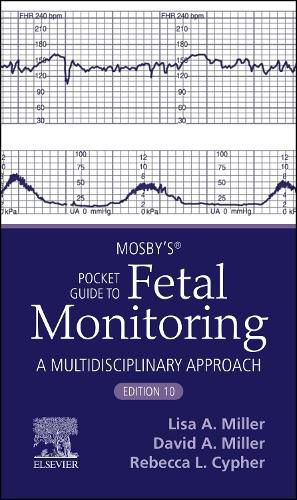Readings Newsletter
Become a Readings Member to make your shopping experience even easier.
Sign in or sign up for free!
You’re not far away from qualifying for FREE standard shipping within Australia
You’ve qualified for FREE standard shipping within Australia
The cart is loading…






Find real-world, clinically useful information on all aspects of electronic fetal monitoring! Authored by a nurse-midwife, a perinatologist, and a nurse, Mosby's Pocket Guide to Fetal Monitoring: A Multidisciplinary Approach, 10th Edition, is an evidence-based resource on fetal heart rate monitoring for all clinicians - whether you are a nurse, a physician, or a midwife, a student or an instructor, this guide has information crucial to your practice. Designed specifically for the clinical environment, it provides a single source for interpretation and management of electronic fetal monitoring in labor and delivery, the intensive care unit, inpatient antepartum units, or the obstetric or midwifery office.
Compact format with vibrant two-color design offers quick and easy access to key information. Prioritization of fetal heart rate and uterine activity assessment, interpretation, and clinical management, grounded in evidence-based practice and current literature, guides you in delivering focused, effective care. Explanations of the relationship between specific fetal heart rate patterns and fetal acidemia provide critical insights for managing condition-specific care. Guidance for safe and competent care is reinforced through patient safety and risk management strategies, illustrated by case studies and legal commentary. Comprehensive guidance on best practices for accurate and timely electronic fetal monitoring documentation covers essential components of fetal heart rate and uterine activity assessment to support clear communication, informed clinical decisions, and legal compliance. Overview of contemporary obstetric models of care - ranging from midwifery-led to physician-led and collaborative approaches - highlights their impact on maternal and neonatal outcomes. Appendix on reviewing electronic fetal monitor tracings serves as a valuable reference and a test bank of questions to aid in certification preparation and knowledge reinforcement. Renowned author team features recognized leaders in the United States and a strong international presence.
New content explores the use of artificial intelligence (AI) in fetal monitoring. Information on the wireless Patch System intrapartum maternal/fetal monitor explores how it noninvasively measures and displays fetal heart rate, maternal heart rate, and uterine activity. Restructured content related to monitoring and clinical management of the preterm fetus includes periviability and multiple gestations. Enhanced coverage addresses maternal cardiac arrest and resuscitative cesarean delivery. Updated recommendations for initiation of antepartum testing include highlighted conditions, gestational age, and frequency. In-depth review of documentation from a risk-management perspective highlights core components of quality charting for nurses, midwives, and physicians, along with the role of the electronic health record. Updated practice recommendations include the latest information on amnioinfusion.
$9.00 standard shipping within Australia
FREE standard shipping within Australia for orders over $100.00
Express & International shipping calculated at checkout
Stock availability can be subject to change without notice. We recommend calling the shop or contacting our online team to check availability of low stock items. Please see our Shopping Online page for more details.
Find real-world, clinically useful information on all aspects of electronic fetal monitoring! Authored by a nurse-midwife, a perinatologist, and a nurse, Mosby's Pocket Guide to Fetal Monitoring: A Multidisciplinary Approach, 10th Edition, is an evidence-based resource on fetal heart rate monitoring for all clinicians - whether you are a nurse, a physician, or a midwife, a student or an instructor, this guide has information crucial to your practice. Designed specifically for the clinical environment, it provides a single source for interpretation and management of electronic fetal monitoring in labor and delivery, the intensive care unit, inpatient antepartum units, or the obstetric or midwifery office.
Compact format with vibrant two-color design offers quick and easy access to key information. Prioritization of fetal heart rate and uterine activity assessment, interpretation, and clinical management, grounded in evidence-based practice and current literature, guides you in delivering focused, effective care. Explanations of the relationship between specific fetal heart rate patterns and fetal acidemia provide critical insights for managing condition-specific care. Guidance for safe and competent care is reinforced through patient safety and risk management strategies, illustrated by case studies and legal commentary. Comprehensive guidance on best practices for accurate and timely electronic fetal monitoring documentation covers essential components of fetal heart rate and uterine activity assessment to support clear communication, informed clinical decisions, and legal compliance. Overview of contemporary obstetric models of care - ranging from midwifery-led to physician-led and collaborative approaches - highlights their impact on maternal and neonatal outcomes. Appendix on reviewing electronic fetal monitor tracings serves as a valuable reference and a test bank of questions to aid in certification preparation and knowledge reinforcement. Renowned author team features recognized leaders in the United States and a strong international presence.
New content explores the use of artificial intelligence (AI) in fetal monitoring. Information on the wireless Patch System intrapartum maternal/fetal monitor explores how it noninvasively measures and displays fetal heart rate, maternal heart rate, and uterine activity. Restructured content related to monitoring and clinical management of the preterm fetus includes periviability and multiple gestations. Enhanced coverage addresses maternal cardiac arrest and resuscitative cesarean delivery. Updated recommendations for initiation of antepartum testing include highlighted conditions, gestational age, and frequency. In-depth review of documentation from a risk-management perspective highlights core components of quality charting for nurses, midwives, and physicians, along with the role of the electronic health record. Updated practice recommendations include the latest information on amnioinfusion.